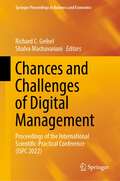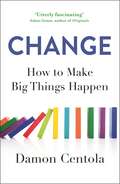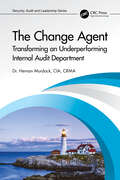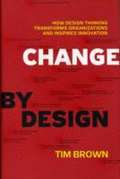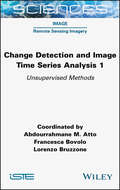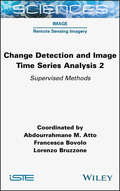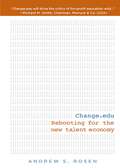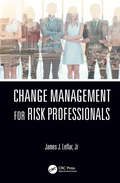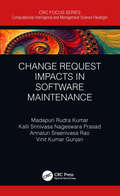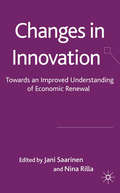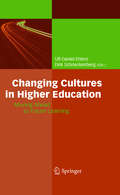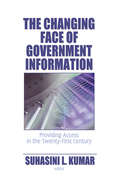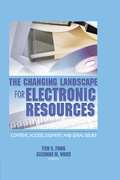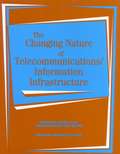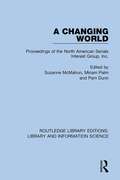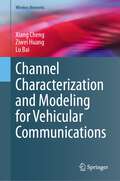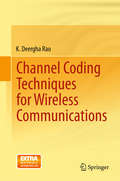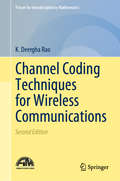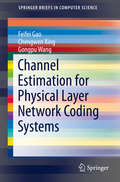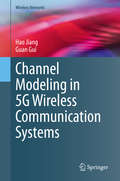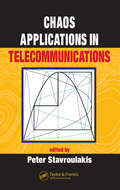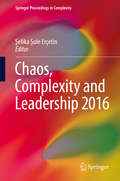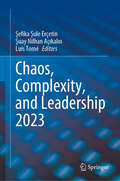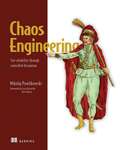- Table View
- List View
Chances and Challenges of Digital Management: Proceedings of the International Scientific-Practical Conference (ISPC 2022) (Springer Proceedings in Business and Economics)
by Richard C. Geibel Shalva MachavarianiThis book presents selected contributions to the International Scientific-Practical Conference 2022 (ISCP 2022) organized by East European University (Georgia) and E-Commerce Institute (Germany). It discusses the possibilities of digital management under current conditions, highlights recent technological advances, and addresses further marketing perspectives. The topics covered include digitalization, digital transformation, e-commerce, artificial intelligence, big data, blockchain, online marketing, the transformation of small and medium-sized businesses, digital law, digital social innovation, and digital ethics.
Change: How to Make Big Things Happen
by Damon Centola'A remarkable and important guide to effecting change in our individual lives, businesses, societies - and beyond' JONAH BERGER, bestselling author of ContagiousHow did movements like the Arab Spring and Black Lives Matter take off when they did? How did Lord Kitchener recruit 2,000,000 volunteers at the start of World War I?Why did Twitter take hold while Google+ has failed?What surprising lessons can we learn from Covid 19?From the spread of Covid-19 to the rise of political polarization, from implicit bias to genetically modified food, from NASA to Netflix - it's time to think differently about how change works.Professor Damon Centola is the world expert in the new science of networks. His ground-breaking research across areas as disparate as voting, health, technology and finance has highlighted powerful and highly effective new ways to ensure lasting change. In this book, Centola distils over a decade of deep experience into a fascinating new theory that challenges previous assumptions that new ideas are either contagious or not. Change shows that beliefs and behaviours are not transmitted from person to person in the simple way that a virus is. The real story of social change is more complex and much more interesting. When we are exposed to a new idea, our social networks guide our responses in striking and surprising ways. Drawing on deep-yet-accessible research and fascinating examples, Change presents a paradigm-shifting new science for understanding what drives change, recognising our blind spots and how we can change the world around us.
The Change Agent: Transforming an Underperforming Internal Audit Department (Security, Audit and Leadership Series)
by Hernan MurdockJohn Taylor has been hired to transform the underperforming internal audit unit at InSports. The auditors are not reviewing what the audit committee and executive leadership consider essential for the organization’s success, their methodology is subpar, and their relationships with their clients are strained. The audit committee has been patient, but not anymore. Their mandate is clear: make clear improvements in one year or the function will be outsourced. This is the story of a visionary leader who needs a strategy to transform processes and deliver better results for stakeholders at all levels within the organization. The audit committee, all levels of management, and employees expect more from internal audit. Now, John must lead the group through 12 challenging months as they focus on what matters most when performing audit and advisory services. They must communicate results faster and better, leverage existing quality control and data analytics techniques, and, with every encounter, help the organization address strategic, operational, compliance, and financial risks. With similarities to "The Goal" and "The Phoenix Project" and leveraging Kotter’s 8-Step Process for Leading Change, follow John and the internal audit team from Boston to New York, San Francisco, London, and Buenos Aires, as they address almost insurmountable challenges in their transformation journey.
Change by Design: How Design Thinking Transforms Organizations and Inspires Innovation
by Tim BrownThe myth of innovation is that brilliant ideas leap fully formed from the minds of geniuses. In reality, most innovations are borne from rigor and discipline.
Change Detection and Image Time-Series Analysis 1: Unsupervised Methods
by Abdourrahmane M. Atto Francesca Bovolo Lorenzo BruzzoneChange Detection and Image Time Series Analysis 1 presents a wide range of unsupervised methods for temporal evolution analysis through the use of image time series associated with optical and/or synthetic aperture radar acquisition modalities. Chapter 1 introduces two unsupervised approaches to multiple-change detection in bi-temporal multivariate images, with Chapters 2 and 3 addressing change detection in image time series in the context of the statistical analysis of covariance matrices. Chapter 4 focuses on wavelets and convolutional-neural filters for feature extraction and entropy-based anomaly detection, and Chapter 5 deals with a number of metrics such as cross correlation ratios and the Hausdorff distance for variational analysis of the state of snow. Chapter 6 presents a fractional dynamic stochastic field model for spatio temporal forecasting and for monitoring fast-moving meteorological events such as cyclones. Chapter 7 proposes an analysis based on characteristic points for texture modeling, in the context of graph theory, and Chapter 8 focuses on detecting new land cover types by classification-based change detection or feature/pixel based change detection. Chapter 9 focuses on the modeling of classes in the difference image and derives a multiclass model for this difference image in the context of change vector analysis.
Change Detection and Image Time Series Analysis 2: Supervised Methods
by Abdourrahmane M. Atto Francesca Bovolo Lorenzo BruzzoneChange Detection and Image Time Series Analysis 2 presents supervised machine-learning-based methods for temporal evolution analysis by using image time series associated with Earth observation data. Chapter 1 addresses the fusion of multisensor, multiresolution and multitemporal data. It proposes two supervised solutions that are based on a Markov random field: the first relies on a quad-tree and the second is specifically designed to deal with multimission, multifrequency and multiresolution time series.Chapter 2 provides an overview of pixel based methods for time series classification, from the earliest shallow learning methods to the most recent deep-learning-based approaches.Chapter 3 focuses on very high spatial resolution data time series and on the use of semantic information for modeling spatio-temporal evolution patterns.Chapter 4 centers on the challenges of dense time series analysis, including pre processing aspects and a taxonomy of existing methodologies. Finally, since the evaluation of a learning system can be subject to multiple considerations,Chapters 5 and 6 offer extensive evaluations of the methodologies and learning frameworks used to produce change maps, in the context of multiclass and/or multilabel change classification issues.
Change.edu
by Andrew S RosenIt's no wonder American higher education is facing a crisis.While low-income students can't find a spot in their local community colleges for lack of funding, public four-year universities are spending staggering sums on luxurious residence halls, ever-bigger football stadiums, and obscure research institutes. We have cosseted our most advantaged students even as we deny access to the working adults who urgently need higher education to advance their careers and our economy. In Change.edu: Rebooting for the new talent economy Andrew S. Rosen clearly and entertainingly details how far the American higher education system has strayed from the goals of access, quality, affordability, and accountability that should characterize our system, and offers a prescription to restore American educational pre-eminence.To change, our system will have to end its reflexive opposition to anything new and different. Rosen describes how each new wave of innovation and expansion of educational access-- starting with the founding of Harvard in 1636, and continuing with the advent of land-grant colleges in the 19th century, community colleges in the 20th century and private sector colleges over the last two decades--has been met with misunderstanding and ridicule. When colleges like the University of California, Cornell and Purdue were founded, they were scorned as "pretenders to the title of university" - language that tracks later criticisms of community colleges and most recently for-profit colleges.Avoiding that condescension is just one of the reasons colleges have come under the sway of "Harvard Envy" - schools that were founded to expand access feel an inexorable tug to become more prestigious and exclusive. Even worse, the competition for the best students has led universities to turn themselves into full-fledged resorts; they've built climbing walls, French bistros and 20-person hot-tubs to entice students to their campuses.How can America address an incentive system in higher education that is mismatched to the challenges of the years ahead? In Change.edu, Rosen outlines "seven certainties" of education in the coming 25 years, and presents an imperative for how our system must prepare for the coming changes. He proposes a new "playbook" for dealing with the change ahead, one that will enable American higher education to regain its global primacy and be a catalyst for economic growth in the 21st century.
Change Management for Risk Professionals
by James J. Leflar JrChange Management for Risk Professionals addresses a need in the marketplace for risk professionals to learn about change management. Organizations exist within a complex and changing environment. The changes within the organizational context (e.g., societal, technological, and customer preferences) place pressure upon the organization to remain relevant and competitive. Change is not inherently wrong; our perceptions of the change make it negative or positive. A perceived negative change can become a real opportunity for improvement if desired. Systemic degradation and irrelevancy are the results of an organization that fails to acknowledge the reality of change. The book focuses on the dynamics of change management with an eye toward the risk professional. There is a real need for an uncomplicated resource that helps educate non-change management professionals involved in risk-oriented change initiatives. Examples of risk disciplines are organizational resilience, business continuity, risk management, crisis management, and security management, but any discipline or function within an organization focuses on risk. Any organizational project is an initiative requiring dynamic change management skills. The author brings his extensive experience to offer risk practitioners advice, industry examples, and best practices to the change management process. Change Management for Risk Professionals will be a welcome addition to enterprise-wide business continuity, crisis management, disaster recovery, security management, and homeland security professionals wanting to learn the secrets to becoming successful in initiating organizational change.
Change Request Impacts in Software Maintenance (Computational Intelligence and Management Science Paradigm)
by Madapuri Rudra Kumar Kalli Srinivasa Prasad Annaluri Sreenivasa Rao Vinit Kumar GunjanThis book discusses Change Management Impact Analysis and how this method is used to analysis the risks and benefits of a change management initiative when it pertains to obtaining critical insight into how the change management program budget should be allotted. The process also offers useful indicators for what areas within the system should be monitored during the change management process. This book presents theoretical analysis of practical implications and surveys, along with analysis. It covers the functions aimed at identifying various stakeholders associated with the software such as requirement component, design component, and class component. The book talks about the interrelationship between the change and the effects on the rest of the system and dives deeper to include the critical role that the analysis places on the existing multiple functions such as estimating the development costs, the project overhead costs, cost for the modification of the system, and system strength or detecting errors in the system during the process. Case studies are also included to help researchers and practitioners to absorb the material presented. This book is useful to graduate students, researchers, academicians, institutions, and professionals that interested in exploring the areas of Impact Analysis.
Changes in Innovation: Towards an Improved Understanding of Economic Renewal
by Jani Saarinen Nina RillaThis book is a collection of articles all contributing to the theme of changes in innovation and innovation processes, and aims to create new knowledge about crucial issues in the Finnish and global innovation environment which forms critical intelligence in innovation strategies for firms and decision makers.
Changing Cultures in Higher Education: Moving Ahead to Future Learning
by Ulf-Daniel Ehlers Dirk SchneckenbergMore and more educational scenarios and learning landscapes are developed using blogs, wikis, podcasts and e-portfolios. Web 2.0 tools give learners more control, by allowing them to easily create, share or reuse their own learning materials, and these tools also enable social learning networks that bridge the border between formal and informal learning. However, practices of strategic innovation of universities, faculty development, assessment, evaluation and quality assurance have not fully accommodated these changes in technology and teaching. Ehlers and Schneckenberg present strategic approaches for innovation in universities. The contributions explore new models for developing and engaging faculty in technology-enhanced education, and they detail underlying reasons for why quality assessment and evaluation in new - and often informal - learning scenarios have to change. Their book is a practical guide for educators, aimed at answering these questions. It describes what E-learning 2.0 is, which basic elements of Web 2.0 it builds on, and how E-learning 2.0 differs from Learning 1.0. The book also details a number of quality methods and examples, such as self-assessment, peer-review, social recommendation, and peer-learning, using illustrative cases and giving practical recommendations. Overall, it offers a step-by-step guide for educators so that they can choose their own quality assurance or assessment methods, or develop their own evaluation methodology for specific learning scenarios. The book addresses everyone involved in higher education - university leaders, chief information officers, change and quality assurance managers, and faculty developers. Pedagogical advisers and consultants will find new insights and practices for the integration and management of novel learning technologies in higher education. The volume fosters in lecturers and teachers a sound understanding of the need and strategy for change, and it provides them with practical recommendations on competence and quality methodologies.
The Changing Face of Government Information: Providing Access in the Twenty-First Century
by Suhasini L. KumarLearn what innovative changes lie in the future of government informationThe Changing Face of Government Information comprehensively examines the way government documents&’ librarians acquire, provide access, and provide reference services in the new electronic environment. Noted experts discuss the impact electronic materials have had on the Government Printing Office (GPO), the reference services within the Federal Depository Library Program (FDLP), and the new opportunities in the transition from paper-based information policy to an electronic e-government. This source reveals the latest changes in the field of government documents librarianship and the knowledge and expertise needed to teach users how to access what they need from this enormous wealth of government information.Major changes have taken place in the way government information is created, disseminated, accessed, and preserved. The Changing Face of Government Information explains in detail the tremendous change taking place in libraries and government documents librarianship. Topics include the increasing accessibility to the federally funded technical report literature, information on the Patriot Act&’s effect on the status of libraries in the aftermath of 9/11, the uses of Documents Data Miner©, and information about catalogs, indexes, and full text databases. This book also provides a selective bibliography of print and electronic sources about Native Americans and the Federal Government, as well as specific sources for information about the environment, such as EPA air data, DOE energy information, information on flora and fauna, hazardous waste, land use, and water. Each chapter is extensively referenced and several chapters use appendixes, tables, and charts to ensure understanding of data.This useful book gives readers the opportunity to learn: how the University of Oregon successfully integrated its business reference service and map collection into its government documents collection the results of a survey of FDLP institutions identifying the factors contributing to the reorganization of services details of the pilot project undertaken by the University of Arizona Library along with the United States Government Printing Office&’s Library Programs Service to create a model for a virtual depository library which critical features are missing in today&’s e-government reference service models details of the GPO&’s plans to provide perpetual access to both electronic and tangible information resources-and the strategies to authenticate government publications on the InternetThe Changing Face of Government Information is stimulating, horizon-expanding reading for librarians, professors, students, and researchers.
The Changing Landscape for Electronic Resources: Content, Access, Delivery, and Legal Issues
by Yem S Fong Suzanne M WardKeep up-to-date with the latest in innovative electronic information services! The Changing Landscape for Electronic Resources: Content, Access, Delivery, and Legal Issues focuses on the effects and challenges of providing electronic resources for libraries. The authors are librarians and other professionals with practical experience in current issues and developing trends. With this book, you will learn about technical, legal, and resource sharing developments that will contribute to the future distribution of global information in libraries. This book shows how libraries using electronic resources can reduce costs and save transaction time for large and small public libraries as well as academic libraries. It also reveals recent initiatives related to open source software and core standards for resource sharing and interlibrary loal, such as the Bath profile and the NISO Circulation Interchange Protocol (NCIP). Special features of this timely book include figures, diagrams, references, and Web sites. This book contains the wisdom and experience of professionals applying electronic resources to: interlibrary loan systems copyright and licensing open source software international data standards scholarly publishingThe Changing Landscape for Electronic Resources will help you avoid many of the potential pitfalls of managing electronic content in the evolving modern library. This book will help you prepare for a future in which electronic access improves the range, speed, and quantity of cost-effective information services for patrons and resource-sharing partners.
Changing Language Education Through CALL (Routledge Studies in Computer Assisted Language Learning #Vol. 1)
by Randall P. Donaldson Margaret A. HaggstromThe last twenty years has seen a huge evolution in approaches to language-learning, due to new technology as well changing theories on how to best teach languages. Recognising the key relationship between research, practice and program development, Changing Language Education Through CALL is an important text advocating change that makes effective use of new research into learning styles, as well as new technology. Bringing together sixteen internationally respected experts in second-language acquisition and computer technologies, it presents teachers with user-friendly, flexible ways to incorporate technology into the language learning process and provides both the theoretical and practical basis for CALL applications across a broad spectrum of teaching styles, textbooks and courses. Practical and clearly presented, each chapter in this book concentrates on the learning process and the teacher’s role in facilitating this through the proper and effective use of technology - thus ensuring that the partnership of pedagogical expertise and technological innovation remains the work’s focus.
The Changing Nature of Telecommunications/Information Infrastructure
by Steering Committee on the Changing Nature of Telecommunications/Information InfrastructureAdvancement of telecommunications and information infrastructure occurs largely through private investment. The government affects the rate and direction of this progress through regulation and public investment. This book presents a range of positions and perspectives on those two classes of policy mechanism, providing a succinct analysis followed by papers prepared by experts in telecommunications policy and applications.
A Changing World: Proceedings of the North American Serials Interest Group, Inc. (Routledge Library Editions: Library and Information Science #1)
by Suzanne McMahon Miriam Palm Pam DunnThis book, first published in 1993, examines how the newest technological developments in information storage and processing impact print-oriented libraries. Find answers to questions on how libraries can utilize the awesome speed, remarkable storage capacity, and universal access of the new technology. Authoritative contributors provide insight, inspirations, and practical experience to the three major areas of changing technologies, changing information worldwide, and strategies and responses of libraries to these rapid changes. A Changing World looks at the future of the electronic network medium and how it will provide opportunities for accessing and using information that so far have been unimagined by the print-dominated information industry. Enlightening chapters explore the feasibility of electronic serials as a realistic replacement for print journals, the future of automated serials control systems, and the effects of information technologies on libraries as systems and librarianship as a profession. Discover timely indications for ten-year trends of the globalization of research, scholarly information, and patents. Specific international influences on information are examined including the implications of the European Community internal market for scholarly publishing and distribution, the influence of rapid changes in Eastern Europe and the former Soviet Union on scholarly publishing, and scholarly information and serials in politically turbulent Latin American countries.
Channel Characterization and Modeling for Vehicular Communications (Wireless Networks)
by Xiang Cheng Ziwei Huang Lu BaiThis book presents and develops comprehensive knowledge of vehicular channel characteristics and proper vehicular channel models. The studied topics contain the propagation characteristics of vehicular communications, such as: a time-frequency non-stationary single-input single-output (SISO) vehicle-to-vehicle (V2V) non-geometry stochastic model (NGSM); a space-time non-stationary massive multiple-input multiple-output (MIMO) V2V regular-shaped geometry-based stochastic model (RS-GBSM); and a space-time non-stationary massive MIMO V2V irregular-shaped geometry-based stochastic model (IS-GBSM). Each is introduced, with characteristics then discussed in detail. Finally, this book discusses future research directions to inspire further investigation in the field of vehicular channels from three different perspectives.
Channel Coding Techniques for Wireless Communications
by K. Deergha RaoThe book discusses modern channel coding techniques for wireless communications such as turbo codes, low parity check codes (LDPC), space-time coding, Reed Solomon (RS) codes and convolutional codes. Many illustrative examples are included in each chapter for easy understanding of the coding techniques. The text is integrated with MATLAB-based programs to enhance the understanding of the subject's underlying theories. It includes current topics of increasing importance such as turbo codes, LDPC codes, LT codes, Raptor codes and space-time coding in detail, in addition to the traditional codes such as cyclic codes, BCH and RS codes and convolutional codes. MIMO communications is a multiple antenna technology, which is an effective method for high-speed or high-reliability wireless communications. PC-based MATLAB m-files for the illustrative examples are included and also provided on the accompanying CD, which will help students and researchers involved in advanced and current concepts in coding theory. Channel coding, the core of digital communication and data storage, has undergone a major revolution as a result of the rapid growth of mobile and wireless communications. The book is divided into 11 chapters. Assuming no prior knowledge in the field of channel coding, the opening chapters (1 - 2) begin with basic theory and discuss how to improve the performance of wireless communication channels using channel coding. Chapters 3 and 4 introduce Galois fields and present detailed coverage of BCH codes and Reed-Solomon codes. Chapters 5-7 introduce the family of convolutional codes, hard and soft-decision Viterbi algorithms, turbo codes, BCJR algorithm for turbo decoding and studies trellis coded modulation (TCM), turbo trellis coded modulation (TTCM), bit-interleaved coded modulation (BICM) as well as iterative BICM (BICM-ID) and compares them under various channel conditions. Chapters 8 and 9 focus on low-density parity-check (LDPC) codes, LT codes and Raptor codes. Chapters 10 and 11 discuss MIMO systems and space-time (ST) coding.
Channel Coding Techniques for Wireless Communications (Forum for Interdisciplinary Mathematics)
by K. Deergha RaoThis book discusses the latest channel coding techniques, MIMO systems, and 5G channel coding evolution. It provides a comprehensive overview of channel coding, covering modern techniques such as turbo codes, low-density parity-check (LDPC) codes, space–time coding, polar codes, LT codes, and Raptor codes as well as the traditional codes such as cyclic codes, BCH, RS codes, and convolutional codes. It also explores MIMO communications, which is an effective method for high-speed or high-reliability wireless communications. It also examines the evolution of 5G channel coding techniques. Each of the 13 chapters features numerous illustrative examples for easy understanding of the coding techniques, and MATLAB-based programs are integrated in the text to enhance readers’ grasp of the underlying theories. Further, PC-based MATLAB m-files for illustrative examples are included for students and researchers involved in advanced and current concepts of coding theory.
Channel Estimation for Physical Layer Network Coding Systems (SpringerBriefs in Computer Science)
by Feifei Gao Chengwen Xing Gongpu WangThis SpringerBrief presents channel estimation strategies for the physical later network coding (PLNC) systems. Along with a review of PLNC architectures, this brief examines new challenges brought by the special structure of bi-directional two-hop transmissions that are different from the traditional point-to-point systems and unidirectional relay systems. The authors discuss the channel estimation strategies over typical fading scenarios, including frequency flat fading, frequency selective fading and time selective fading, as well as future research directions. Chapters explore the performance of the channel estimation strategy and optimal structure of training sequences for each scenario. Besides the analysis of channel estimation strategies, the book also points out the necessity of revisiting other signal processing issues for the PLNC system. Channel Estimation of Physical Layer Network Coding Systems is a valuable resource for researchers and professionals working in wireless communications and networks. Advanced-level students studying computer science and electrical engineering will also find the content helpful.
Channel Modeling in 5G Wireless Communication Systems (Wireless Networks)
by Guan Gui Hao JiangThis book addresses the fundamental design and technical challenges for fifth generation (5G) wireless channel models, including multi-frequency bands and multi-scenarios. The book presents a strong vision for 5G wireless communication networks based on current market trends, proven technologies, and future directions. The book helps enable researchers and industry professionals to come up with novel ideas in the area of wireless heterogeneity, to minimize traffic accidents, to improve traffic efficiency, and to foster the development of new applications such as mobile infotainment. The book acts as a comprehensive reference for students, instructors, researchers, engineers, and other professionals, building their understanding of 5G and in designing 5G systems.Addresses fundamental design and technical challenges for 5G wireless channel models;Presents how to create reliable statistical channel models to capture the propagation properties between transmitters and receivers;Pertinent to researchers, engineers, and professionals in 5G.
Chaos Applications in Telecommunications
by Rajeev BansalThe concept of transmitting information from one chaotic system to another derives from the observation of the synchronization of two chaotic systems. Having developed two chaotic systems that can be synchronized, scientists can modulate on one phase signal the information to be transmitted, and subtract (demodulate) the information from the corres
Chaos, Complexity and Leadership 2016
by Şefika Şule ErçetinThis book covers the proceedings from the 2016 International Symposium on Chaos, Complexity and Leadership, and reflects current research results of chaos and complexity studies and their applications in various fields. Included are research papers in the fields of applied nonlinear methods, modeling of data and simulations, as well as theoretical achievements of chaos and complex systems. Also discussed are leadership and management applications of chaos and complexity theory.
Chaos, Complexity, and Leadership 2023
by Şefika Şule Erçetin Şuay Nilhan Açıkalın Luís ToméThe proceedings of the 8th International Symposium on Chaos, Complexity, and Leadership present various concepts of diverse research methodologies to explore chaos and complexity across different scientific fields of leadership. Particular emphasis will be placed on investigating non-linearity to stimulate discussion on novel approaches and perspectives regarding chaos, complexity, and leadership. The book delves into recent developments from diverse fields, employing chaos and complexity theory as analytical tools. Readers will find insights into important contemporary events, regardless of the various perspectives across social, political, economic, or scientific domains. It integrates numerous aspects and challenges regarding the impact of chaos and complexity on our world, utilizing nonlinear dynamics to suggest transformative policies. It aims to investigate and predict future paths through an interdisciplinary approach. Given the current societal and economic turbulence, leadership across all sectors necessitates reassessment. Consequently, this book primarily targets individuals interested in nonlinear science and leadership. However, its content extends its appeal to a broader audience due to its application of chaos and complexity to other disciplines. The primary audience comprises academics, professionals, and decision-makers seeking to implement new approaches and methodologies in practice.
Chaos Engineering: Site reliability through controlled disruption
by Mikolaj PawlikowskiChaos Engineering teaches you to design and execute controlled experiments that uncover hidden problems.Summary Auto engineers test the safety of a car by intentionally crashing it and carefully observing the results. Chaos engineering applies the same principles to software systems. In Chaos Engineering: Site reliability through controlled disruption, you&’ll learn to run your applications and infrastructure through a series of tests that simulate real-life failures. You'll maximize the benefits of chaos engineering by learning to think like a chaos engineer, and how to design the proper experiments to ensure the reliability of your software. With examples that cover a whole spectrum of software, you'll be ready to run an intensive testing regime on anything from a simple WordPress site to a massive distributed system running on Kubernetes. Purchase of the print book includes a free eBook in PDF, Kindle, and ePub formats from Manning Publications. About the technology Can your network survive a devastating failure? Could an accident bring your day-to-day operations to a halt? Chaos engineering simulates infrastructure outages, component crashes, and other calamities to show how systems and staff respond. Testing systems in distress is the best way to ensure their future resilience, which is especially important for complex, large-scale applications with little room for downtime. About the book Chaos Engineering teaches you to design and execute controlled experiments that uncover hidden problems. Learn to inject system-shaking failures that disrupt system calls, networking, APIs, and Kubernetes-based microservices infrastructures. To help you practice, the book includes a downloadable Linux VM image with a suite of preconfigured tools so you can experiment quickly—without risk. What's inside Inject failure into processes, applications, and virtual machines Test software running on Kubernetes Work with both open source and legacy software Simulate database connection latency Test and improve your team&’s failure response About the reader Assumes Linux servers. Basic scripting skills required. About the author Mikolaj Pawlikowski is a recognized authority on chaos engineering. He is the creator of the Kubernetes chaos engineering tool PowerfulSeal, and the networking visibility tool Goldpinger. Table of Contents 1 Into the world of chaos engineering PART 1 - CHAOS ENGINEERING FUNDAMENTALS 2 First cup of chaos and blast radius 3 Observability 4 Database trouble and testing in production PART 2 - CHAOS ENGINEERING IN ACTION 5 Poking Docker 6 Who you gonna call? Syscall-busters! 7 Injecting failure into the JVM 8 Application-level fault injection 9 There's a monkey in my browser! PART 3 - CHAOS ENGINEERING IN KUBERNETES 10 Chaos in Kubernetes 11 Automating Kubernetes experiments 12 Under the hood of Kubernetes 13 Chaos engineering (for) people
